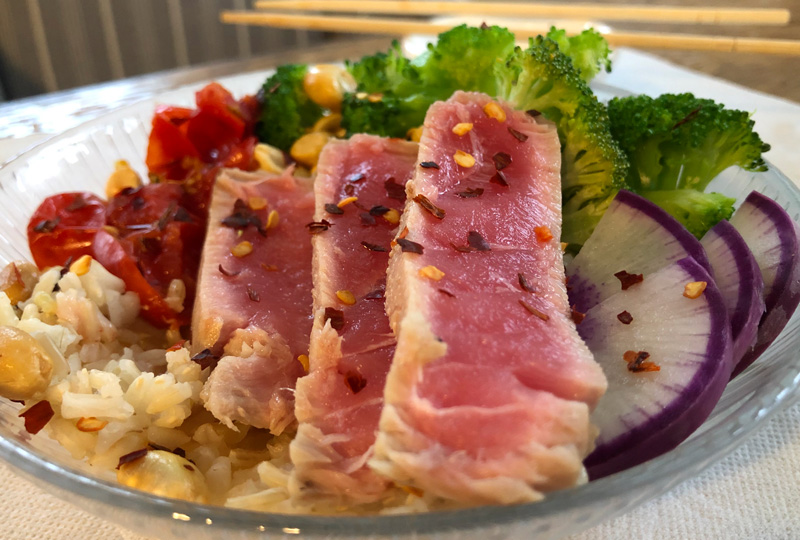With whole grains, lean proteins and plenty of flavor, these one-dish meals are a weekend food-prepper’s dream.
Trendy one-dish healthy grain bowls have been showing up on restaurant menus for a while now. Dining spots everywhere are serving up everything from a gingery Asian tofu bowl, to a spicy southwestern chicken bowl. But, wouldn’t it be great to create your own personalized healthy grain bowls at home? With a basic strategy for which flavors work well together, it’s easy to bring the ease of this one-dish delight to your own dining table. Best of all, there is no right or wrong way to make a healthy grain bowl, so you really can’t go wrong.
Build your bowl with a base grain, lots of vegetables, a lean protein, toppings, and a drizzle of sauce. Be sure to make your recipe a healthy one by choosing whole grains and meats that are lean. Use caution when selecting toppings; go easy on the high-calorie ones. When using sauces, drizzle them on lightly to enhance the flavor, not overpower it.
Below are a few ideas to help get you started, and a recipe for an easy to make Ahi Tuna Power Bowl. Once you have a template to build on, make your own masterpiece.
| Bowl | Grain | Produce | Protein | Toppings | Sauce |
|---|---|---|---|---|---|
| Asian-inspired Bowl | Soba noodles | Snow peas, cabbage, cucumber, carrots | Beef or firm tofu | Toasted sesame seeds, shredded ginger, edamame | Blend fish sauce, lime juice, a pinch of sugar and minced garlic |
| Spicy Southwestern Bowl | Brown rice | Avocado, corn, tomatoes, scallions | Chicken, shrimp or black beans | Baked tortilla chips, green chilis, cilantro | Salsa, low-fat yogurt or sour cream |
| Vegetarian Bowl | Quinoa or lentils | Roasted mushrooms, sauteed red onion, sweet potato cubes | Firm tofu | Pumpkin seeds, chickpeas | Low-fat buttermilk and mayo, white vinegar, garlic, dill |
| Breakfast Bowl | Oatmeal | Berries, bananas or raisins | Chopped almonds, pecans or walnuts | Cinnamon | Honey or maple syrup |
Cook’s tips:
- Don’t pre-make your bowls. Customizing on the spot is part of the fun.
- Consider prepping for the week and your bowl creations will be a cinch:
- Cook grains ahead of time and store them in the refrigerator.
- Heat up the grill or oven and cook several proteins at one time.
- For easier clean-up, roast a variety of vegetables on one sheet pan in the oven.
- Make enough so that you have extra on hand for quick at-home prep or for on the go.
Ahi Tuna Power Bowl
Ingredients
For the Sauce:
- 1/2 tablespoon low-sodium soy sauce
- 2 tablespoons rice vinegar
- ½ teaspoon toasted sesame oil
- ½ tablespoon honey
- Juice of 1 lime
For the Bowl:
- 1 cup cooked brown rice
- 1 cup broccoli florets
- 6 cherry tomatoes
- 3 ounces of Ahi tuna steak (chicken, tofu or salmon would also work well)
- 1 sliced daikon or regular radish, thinly sliced
- ¼ cup peanuts (or other nuts for crunch)
Instructions
- Make the sauce by whisking all ingredients together. Set aside.
- Cook the rice according to the package directions. While the rice is cooking: a. Roast the broccoli florets and tomatoes on a cookie sheet in the oven for 15 minutes on 400 degrees. b. Heat a non-stick pan or well-seasoned iron skillet on high. Sear the fish for approximately 2 minutes on each side (less for rare, more for medium). Remove the fish from the pan right away, and slice thinly.
- Add the rice to the serving bowl. Top with the cooked vegetables, tuna slices and radishes. Top with the optional hot pepper flakes for extra heat and the peanuts for crunch.
- Drizzle lightly with the sauce.
Nutrition Information
Serving Size: 1 serving For the bowl: Calories: 549 Total Fat: 17 grams Saturated Fat: 3 grams Cholesterol: 38 milligrams Sodium: 329 milligrams Potassium: 1,048 milligrams Protein: 36 grams Vitamin A: 80% Vitamin C: 194%. | For the sauce: Calories: 65 Total Fat: 2 grams Saturated Fat: 0.3 grams Sodium: 286 miligrams Potassium: 85 milligrams Sugars: 9.6 grams Vitamin C: 22.1%.
Notes
• Microwave the veggies instead of roasting them to speed things up a bit. • The American Heart Association recommends no more than 2,300 milligrams (mg) of sodium a day and moving toward an ideal limit of no more than 1,500 mg per day for most adults. Using a lower-sodium soy sauce for this recipe, and drizzling the sauce sparingly both will help you keep the sodium in check. However, if you want to leave the soy sauce out completely, consider using pineapple juice in its place.

